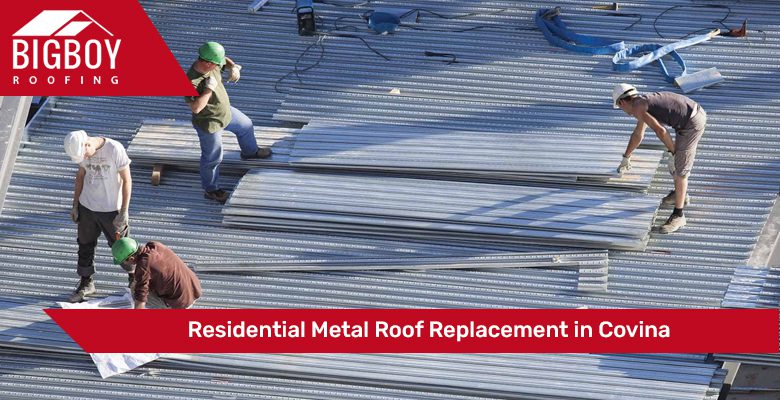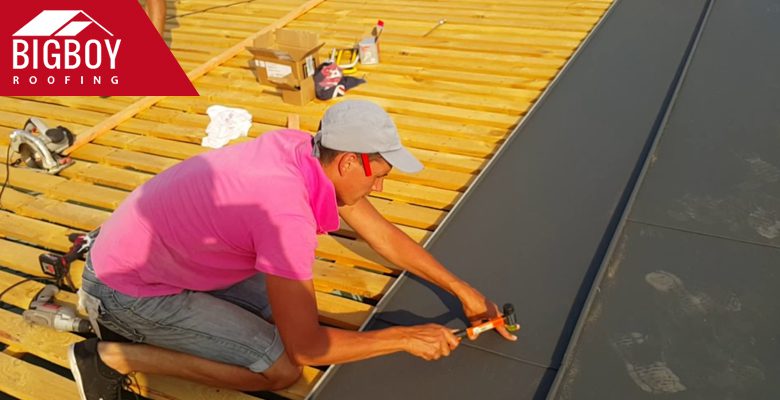Residential Metal Roof Replacement
We understand that the decision to get a residential metal roof replacement can be significant, filled with concerns and questions about the process, costs, and finding the right professionals for the job.

In this blog post, we aim to guide you through every step of the way. With the expertise of our Covina roofing contractors, you can be sure that the process will be as stress-free and easy as possible.
Common Reasons for Residential Asphalt Shingle Roof Replacement
There are several common reasons why homeowners opt for residential asphalt shingle roof replacement with our roofing experts. These reasons include the following:
I. Age: Asphalt shingle roofs have a limited lifespan, typically 20 to 30 years. If your roof is nearing or has exceeded its expected lifespan, it may be time for a replacement. Aging shingles become brittle, lose granules, and are more susceptible to damage.
II. Damage from weather: Severe weather events, such as hailstorms, high winds, or heavy snow, can cause significant damage to asphalt shingle roofs. Shingles may become cracked, lifted, or dislodged, leading to water infiltration and leaks.
III. Leaks and water damage: Persistent roof leaks that cannot be effectively repaired may indicate underlying issues with the roofing system. If water is penetrating through multiple areas of the roof, it may be a sign that the shingles and other components have deteriorated beyond repair.
IV. Widespread shingle deterioration: Over time, asphalt shingles can deteriorate due to exposure to sunlight, temperature fluctuations, and moisture. If you notice widespread shingle deterioration, such as cracking, curling, or excessive granule loss, it may indicate that the shingles have reached the end of their lifespan.
Causes of Residential Metal Roof Damage
Residential metal roofs are generally durable and long-lasting, but they can still be subject to damage under certain conditions. Here are some common causes of residential metal roof damage:
| Causes | Description |
| Impact damage | Metal roofs can sustain damage from falling objects, such as tree branches, debris, or hailstones. These impacts can cause dents, scratches, or punctures in the metal surface. |
| Extreme weather conditions | Severe weather events like hurricanes, strong winds, heavy rainstorms, or snowstorms can pose a risk to metal roofs. |
| Improper installation | Incorrect installation of a metal roof can result in damage over time. If the panels are not properly secured, fastened, or aligned, they may be prone to wind uplift, causing them to loosen or detach. |
| Expansion and contraction | Metal roofs expand and contract with temperature fluctuations. Over time, this movement can cause the fasteners to loosen or the metal panels to warp. |
How Is Residential Metal Roof Replacement Done?
Residential metal roof replacement by our Covina roofing experts involves several steps to ensure a proper and successful installation. Here is a general outline of the process:

I. Inspection and preparation: The first step is to assess the condition of the existing metal roof. Our roofing contractor will inspect the roof for any damage, corrosion, or areas of concern.
II. Material selection: Once the inspection is complete, you will work with the roofing contractor to select the type and style of metal roofing material that suits your preferences and budget. Various options are available, such as steel, aluminum, copper, or zinc.
III. Removal of existing roof: The existing metal roof will be removed to provide a clean and stable surface for the new roof installation. This may involve removing the metal panels, underlayment, flashing, and any other components specific to the existing roof system.
IV. Repair and preparation of the roof deck: The roof deck will be inspected for any damage or rot. Any necessary repairs or replacement of damaged sections will be carried out. The roof deck must be solid and in good condition to support the new metal roof.
V. Installation of underlayment and insulation: A layer of underlayment, such as synthetic underlayment or self-adhering membrane, will be installed over the roof deck. This underlayment provides an additional moisture barrier and helps protect against water infiltration. If desired or necessary, insulation materials may be added for energy efficiency.
VI. Flashing and trim installation: Metal flashing, such as drip edges, valley flashing, and sidewall flashing, will be installed to ensure proper water drainage and prevent leaks at vulnerable areas of the roof.
VII. Metal roof panel installation: The metal roof panels are installed according to the manufacturer’s guidelines and the specific design of your roof. Each panel is carefully aligned, fastened, and interlocked with adjacent panels to create a secure, watertight roofing system.
Book a roofing consultation with our expert roofing contractors now!
Our experts will answer all your questions, address any concerns, and guide you through every step of the roofing project. We are here to provide you with the knowledge and support you need to make informed decisions.
FAQs
When should I consider replacing my residential metal roof?
It is generally recommended to consider replacing your residential metal roof when it has reached the end of its lifespan (typically 40-70 years) or if it has sustained significant damage that cannot be effectively repaired.
How long does a residential metal roof replacement typically take?
The duration of a metal roof replacement project depends on various factors such as the roof’s size, the design’s complexity, and weather conditions. It can take anywhere from a few days to a couple of weeks.
Can a metal roof be installed over the existing roof?
In some cases, metal roofs can be installed over the existing roof. However, it is essential to consult with a professional roofing contractor to assess the structural integrity of the current roof and determine if it can support the additional weight of the metal roof.
What are the benefits of replacing my residential roof with metal?
Replacing your residential roof with metal offers several benefits, including exceptional durability, longevity, fire resistance, energy efficiency, low maintenance requirements, and an attractive appearance that can enhance your home’s curb appeal.

